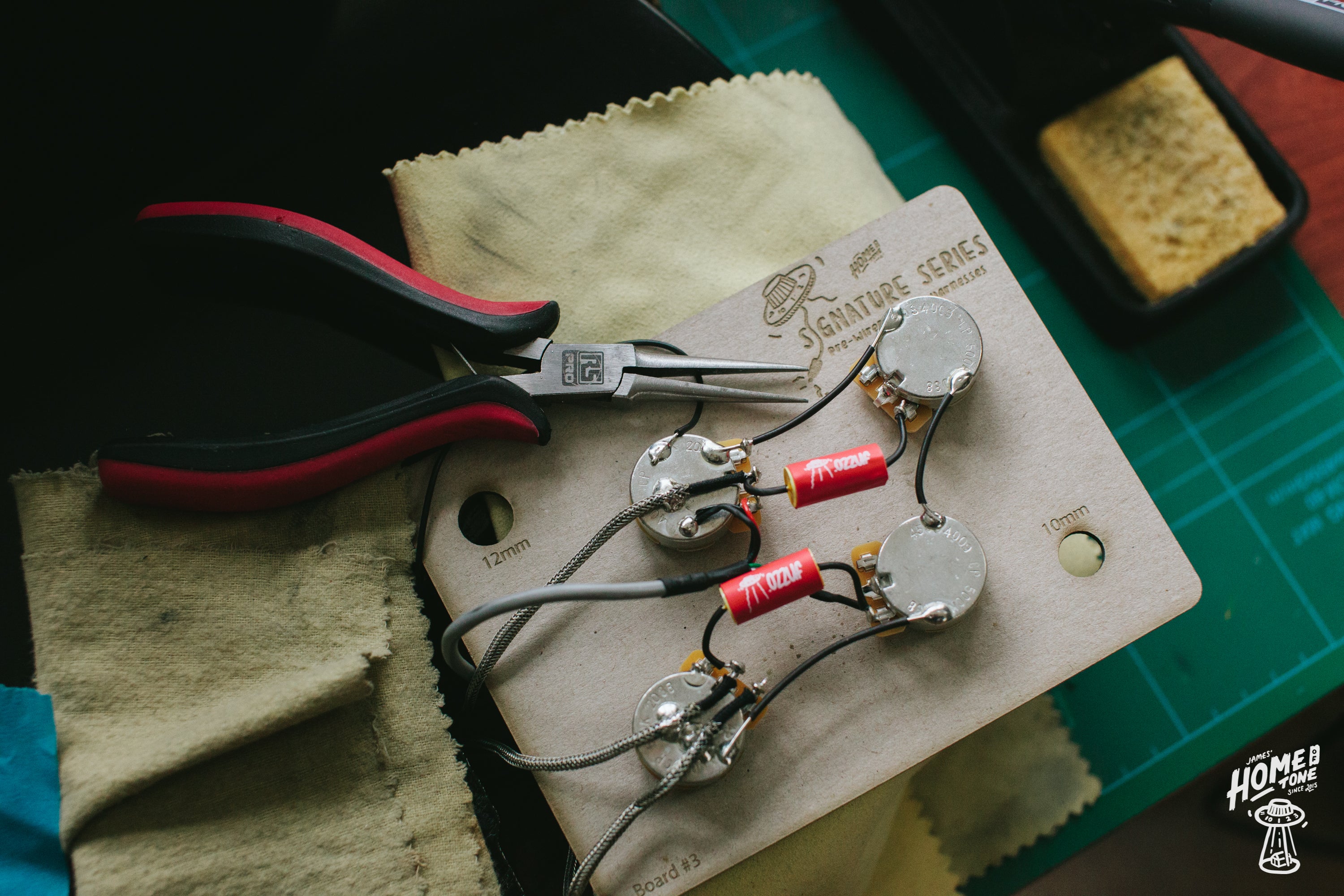So hopefully this little article will look at why they're like this, how you can change it if that's something you'd like to try, and what benefits/downfalls there are to each style. Maybe it will help you decide which is right for you and how you like to use your guitar's controls.
Traditional 'dependant' or 'coupled' Volume controls
So this is the method of wiring more than likely inside your Gibson style guitar. As you can see from viewing the link to the diagram below, your pickup wire is going to it's relevant volume pot's 'input' lug. With the wire going to the pickup selector switch connecting to the pot's sweeper, or 'output' lug in the middle.
Traditional '50s' style Les Paul wiring diagram
One benefit of this wiring style is that the somewhat 'natural' loss of treble frequencies found when rolling down your volume pot is slightly more manageable and useable for the player, or can certainly be improved upon by a simple 'treble bleed' mod, such as 50s style wiring, or an additional cap and resistor combination adding between those two input and output lugs. The downside is that when in the middle position, when you roll down one pickup's volume control all of the way, your signal will cut out completely. Despite having the other pickups volume control turned up. As mentioned earlier, this is the method most players will be familiar with, even using it as an effect like a kill switch for example. But if you've ever wondered why this method is the 'standard', and that surely having those volume controls working fully independently would be loads better, then hopefully the below info will help indulge that curiosity.
'Independent' or 'Decoupled' wired volume controls
So with the more traditional, commonly found dependant wired controls briefly covered above. Let's look and how those volume controls can be wired to function 'independently' so to speak. It's simply done by reversing the above connections regarding the input and output of the volume pot. Your pickup signal wire now needs to be connected to the middle, sweeper 'output' lug of the volume pot. With the switch wire to the 'input' lug of the volume pot instead. This style of wiring and how the controls work may suddenly become familiar to you if you have ever played, or wired up say, a Fender Jazz bass for example. This allows the volume controls to work somewhat independently to each other, but it's not quite as simple as putting the cover back on and enjoying your new decoupled controls. You've essentially changed the way the pickups and circuit interact, which does actually affect resistance. What that means is you will likely experience a more dramatic effect on the treble frequencies through even minor adjustments to each volume control. So although this still happens with dependant volume controls, it is far less drastic than with this wiring method.
Independent 'decoupled' 50s Les Paul wiring diagram
But if it has such a negative effect on the volume pot sweep, then why is it used in a Jazz bass etc? Fair question, for this I would recommend spending some time playing a Jazz bass, getting a feel for it's controls and how it is wired. I say this because it still isn't really an 'ideal' solution, especially so because the tone pot is at the end of the circuit making for some quirks in interaction between the volume and tone controls. 'Humps' in adjustments and again, the loss of treble upon roll off of each volume. In a bass of course that treble loss might not be quite as much of an issue as it would be for most 6 string guitarists for example. Again though, you could help resolve some of this with the use of a treble bleed mod. It may require a little trial and error to find the value of cap and resistor, and style that suits you and gets the best from the volume pot sweep again, but it will certainly help improve the volume controls.
In Summary
My best guess is that the manufacturers stick with dependant wiring, and have done for decades with models like the Les Paul for example is because it simply makes the volume controls work more effectively than when they're wired independently, despite the signal cut off compromise. Whether it is perfect for you one way or the other, that's for you to decide ultimately! But I hope this little article helps you in making your decision or perhaps with some experimentation. It's a simple mod to do if you're comfortable with a soldering iron, so if you have a lazy Sunday spare, give it a whirl! See which method works for you, maybe the compromises either way are outweighed by the advantages.
As always, if you are taking on any guitar mods or wiring work, be sure to have the correct tools and take care of yourself and your guitar.
Although these wiring diagrams are on public display here in this article, It is important to note that the diagrams correspond to my harnesses and wiring work I have done, and more importantly, the specific components I use within those harness kits. So if you are wiring something up yourself, there is a chance you're using components different to those displayed on these diagrams so they may, or may not match up. So please double check your components, ensure they're the same type as those displayed on my diagrams to help ensure when you follow the diagram you wire it all up correctly. I cannot hold any liability for issues from choosing to follow one of my wiring diagrams as these are free to use and all risk is upon yourself.
James
Have you made good use of some of the free resources here? Wired up your guitar or found useful info here along the way? Perhaps you might consider kindly supporting this free resource for guitarists via 'Buy me a coffee'! Thank you so much!



Comments
As an a bassist mostly I alway found the tradition Gibson wiring frustrating…
I got so use to manipulating the jazz bass two vol system with a quick adjustment for tone meaning more treble = more bridge etc… then there’s the single coil buzz issue that’s solved (mostly lol) when both volumes are equal throughout the range…
that being said, I was wondering if the Gibson non traditional independent volumes wiring is used, it stands to reason that the switch becomes perhaps irrelevant while the tradition wiring, with the switch, provides “presets” for both pickups…
then there’s patent infringement issues amounts manufactures… functionality, preferences, and tradition come to mind.
As an aside: Using the independent volumes, perhaps the switch could be replace by a master volume somewhat like what gretch does with some of their instruments.
Surely someone has tried that…
So glad I found your article! Not much info on the subject out there. The coupled wiring in my SG’s was frustrating. I had figured the independent wiring concept out but was wanting some confirmation from someone with more knowledge than me. Adding a treble bleed circuit to each volume pot has solved any I’ll effects the "backwards"wiring may have caused. For me anyways. Plan on experimenting with the tone capacitor position to finalize my tonal groove! THANKS!
Thing about the dependent wiring approach is that the amp’s input is effectively grounded when you turn the volume to zero. You don’t get weird static noises coming out of your amp due to a ‘floating’ input.
Hi Shawn,
Superb! Great to hear that it works for you. As I say in the article, it is totally personal preference, which you prefer is personal preference! This article simply helps describe the difference and what to expect from each :) Glad to hear you have found a method you prefer and that works for you! Enjoy :)
i hate the dependent wiring!, i had a custom electra les paul style guitar and it was independent controlled. loved it! i had no problem with the electra! epiphone les paul i have now. dislike the volume control wiring!